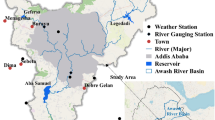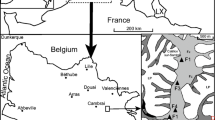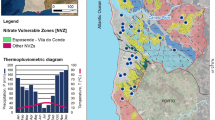Abstract
Intensification of potato farming has contaminated groundwater with nitrate in many cases in Prince Edward Island, Canada, which raises concerns for drinking water quality and associated ecosystem protection. Numerical models were developed to simulate nitrate-N transport in groundwater and enhance understanding of the impacts of farming on water quality in the Wilmot River watershed. Nitrate is assumed non-reactive based on δ15N and δ18O in nitrate and geochemical information. The source functions were reconstructed from tile drain measurements, N budget and historical land-use information. The transport model was calibrated to long-term nitrate-N observations in the Wilmot River and verified against nitrate-N measurements in two rivers from watersheds with similar physical conditions. Simulations show groundwater flow is stratified and vertical flux decreases exponentially with depth. While it would take several years to reduce the nitrate-N in the shallow portion of the aquifer, it would take several decades or even longer to restore water quality in the deeper portions of the aquifer. Elevated nitrate-N concentrations in base flow are positively correlated with potato cropping intensity and significant reductions in nitrate-N loading are required if the nitrate level of surface water is to recover to the standard in the Canadian Water Quality Guidelines.
Résumé
L’intensification de la culture de la pomme de terre a entraîné une contamination en nitrates des eaux souterraines dans plusieurs secteurs de l’île Edouard au Canada qui présentent maintenant des problèmes de qualité des eaux potables et de protection des écosystèmes associés. Des modèles numériques ont été développés pour simuler le transport de l’azote dans les aquifères et améliorer la compréhension de l’impact de la culture sur la qualité des eaux souterraines dans le bassin de la rivière Wilmot. D’après les données de δ15N et δ18O des nitrates et l’information géochimique, les nitrates sont considérés comme non-réactifs. Les fonctions d’origine sont construites à partir de mesures effectuées sur les drains agricoles, le bilan d’azote et l’historique des informations sur l’utilisation des terres. Le modèle de transport est calibré pour de longues chroniques de mesures d’azote de la rivière Wilmot et vérifié avec les mesures d’azote de deux rivières de bassins versants présentant des caractéristiques physiques similaires. Les simulations montrent que l’écoulement souterrain est stratifié avec des flux verticaux décroissant exponentiellement avec la profondeur. Alors que la diminution des concentrations en nitrates prendra plusieurs années dans les horizons superficiels de l’aquifère, il prendra plusieurs dizaines d’années ou plus pour restaurer la qualité des eaux souterraines profondes. Le flux de base présente des concentrations en nitrates élevées corrélées positivement avec l’intensité de la culture de la pomme de terre. Une réduction importante des apports azotés est nécessaire pour que les eaux de surface retrouvent des niveaux respectant les standards de qualité pour les eaux au Canada.
Resumen
La intensificación del cultivo de la papa ha contaminado las aguas subterráneas con nitrato en muchos casos en Isla Prince Edward, Canadá, lo cual ha suscitado preocupaciones con respecto a la calidad del agua potable y de la protección de los ecosistemas asociados. Se desarrollaron modelos numéricos para simular el transporte del nitrato-N en aguas subterráneas y para mejorar la comprensión de los cultivos de la agricultura sobre calidad del agua en la cuenca del río Wilmot. Se supone que el Nitrato es no-reactivo sobre la base de δ15N y δ18O en nitrato e información geoquímica. Las funciones fuentes fueron reconstruidas a partir de mediciones en canales de drenaje, balance de N e información de uso histórico de la tierra. El modelo de transporte fue calibrado a largo plazo con observaciones de nitrato-N en el río Wilmot y verificado con medidas de nitrato-N en dos ríos de cuencas hidrográficas con condiciones físicas similares. Las simulaciones mostraron que el flujo subterráneo es estratificado y el flujo vertical disminuye exponencialmente con la profundidad. Mientras que tomaría varios años reducir el nitrato-N en la parte somera del acuífero, llevaría varias décadas o incluso más tiempo para restaurar la calidad del agua en las porciones profundas del acuífero. Las elevadas concentraciones de nitrato-N en el flujo de base están correlacionadas positivamente con la intensidad de las cosechas de la papa y se requieren reducciones significativas en la carga de nitratos- N para recuperar el nivel de nitrato del agua superficial de acuerdo a las normas de calidad del agua canadiense.
摘要
马铃薯种植业的扩张导致加拿大爱德华王子岛发生多例地下水硝酸盐污染, 引起了对饮用水水质和相关生态系统保护的关注. 本文建立了地下水中硝态氮运移的数值模型, 从而加深了耕作对威尔莫特河盆地水质影响的理解. 基于硝酸根δ15N 和 δ18O 数据及地球化学信息, 认为硝酸盐不具有反应性. 基于瓦管排水测量、N均衡和土地利用的历史等信息重建了污染输入函数. 应用威尔莫特河硝态氮的长期观测数据对运移模型进行了标定, 并通过物理条件相似流域的两条河流的硝态氮测量数据对模型进行了验证. 模拟显示地下水流是分层的, 且垂向通量随深度呈指数衰减. 降低浅部含水层中的硝态氮需要几年的时间, 而恢复深部含水层的水质则需数十年或更长的时间. 基流中硝态氮浓度的升高与马铃薯种植密度正相关, 若要地表水中的硝酸盐含量恢复到加拿大水质规范中的标准, 必须显著减小硝态氮载荷.
Resumo
A intensificação da cultura da batata em Prince Edward Island, Canadá, em muitos casos contaminou a água subterrânea por nitrato, o que levanta questões sobre a qualidade da água para consumo humano e sobre a protecção dos ecossistemas associados. Foram desenvolvidos modelos numéricos para simular o transporte de nitrato-N na água subterrânea e aumentar o conhecimento sobre os impactos da agricultura na qualidade da água na bacia hidrográfica do rio Wilmot. Assumiu-se que o nitrato é não-reactivo com base nos valores de δ15N e δ18O do nitrato e na informação geoquímica. As funções de entrada foram reconstruídas a partir de medições em drenos agrícolas, balanços do azoto e informação histórica sobre o uso do solo. O modelo de transporte foi calibrado com séries temporais de nitrato-N no rio Wilmot e verificado contra medições de nitrato-N em dois rios de bacias hidrográficas com características físicas similares. As simulações demonstram que o escoamento subterrâneo é estratificado e que o fluxo vertical diminui exponencialmente com a profundidade. Enquanto seriam necessários vários anos para reduzir a concentração de nitrato-N nas zonas mais superficiais do aquífero, seriam precisas várias décadas, ou até mais tempo, para restaurar a qualidade da água nas zonas mais profundas do aquífero. As concentrações elevadas de nitrato-N no escoamento de base correlacionam-se positivamente com a intensidade do cultivo da batata e verifica-se a necessidade de reduções significativas na fertilização com nitrato-N para que os níveis de nitrato na água superficial recuperem para os teores admitidos nos Canadian Water Quality Guidelines.














Similar content being viewed by others
References
Almasri MN, Kaluarachchi JJ (2004) Assessment and management of long-term nitrate pollution of groundwater in agriculture-dominated watersheds. J Hydrol 295:225–245
Bohlke JK (2002) Groundwater recharge and agricultural contamination. Hydrogeol J 10:153–179
Buss SR, Rivett MO, Morgan P, Bemment CD (2005) Attenuation of nitrate in the sub-surface environment. Science Report SC030155/SR2, Environment Agency, Brisol, UK
Carr PA (1969) Salt-water intrusion in Prince Edward Island. Can J Earth Sci 6:63–74
Carr PA (1971) Use of harmonic analysis to study tidal fluctuations in aquifers near the sea. Water Resour Res 7:632–643
Carr PA, van der Kamp GS (1969) Determining aquifer characteristics by tidal method. Water Resour Res 5:1023–1031
Delcom Consultants Inc. (1994) Draft report on Linkletter and Wilmot well field exploration and development. Delcom, Summerside, PEI, Canada
Delgdo JA, Riggenbach RR, Sparks RT, Dillon MA, Kawanabe LM, Ristau RJ (2001) Evaluation of nitrate-nitrogen transport in a potato-barley rotation. Soil Sci Soc Am J 65:878–883
Environment Canada (2005a) Environment Canada Environdat database. http://map.ns.ec.gc.ca/envirodat/root/main/en/main_e.asp. Cited 20 November 2006
Environment Canada (2005b) Canadian water quality guidelines: nitrate. http://www.ec.gc.ca/ceqg-rcqe/English/download/default.cfm. Cited 5 Oct 2005
Francis RM (1989) Hydrogeology of the Winter River Basin, Prince Edward Island. Department of the Environment, Charlottetown, PEI, Canada
Freeze RA, Witherspoon PA (1967) Theoretical analysis of regional groundwater flow: 2. effect of water-table configuration and subsurface permeability variation. Water Resour Res 3:623–634
Gelhar LW, Welty C, Rehfeldt KR (1992) A critical review of data on field-scale dispersion in aquifers. Water Resour Res 28:1955–1974
Health Canada (2007) Canadian Drinking Water Guidelines. Health Canada, Ottawa. http://www.hc-sc.gc.ca/ewh-semt/water-eau/dayrink-potab/guide/. Cited 14 November 2007
Ivany JA, Sanderson JB (2001) Response of potato (Solanum tuberosum) cultivars to glufosinate-ammonium and diquat used as desiccants. Weed Technol 15:505–510
Ivany JA, White RP, Sanderson JB (1986) Effect of applied fertilizer on Kennebec potato to desiccation and yield with diquat. Am Potato J 63:545–552
Jacques Whitford Consulting Engineers and Scientists (1990) Water supply and wastewater treatment for industrial development in Prince Edward Island. Department of Industry, charlottetown, PEI, and Atlantic Canada Opportunities Agency, Moncton, NB, Public Works Canada, Gatineau, Quebec
Jiang Y, Somers GH, Mutch J (2004) Application of numerical modeling to groundwater assessment and management in Prince Edward Island. Paper presented at the 57th Canadian Geotechnical Conference and the 5th Joint CGS/IAH-CNC Conference, Quebec City, 24–27 October 2004
Jiang Y, Somers GH, Paradis D (2007) Estimation of groundwater residence times in the Wilmot River watershed in Prince Edward Island: implications for nutrient reduction. Paper presented at the 60th Canadian Geotechnical Conference and 8th Joint CGS/IAH-CNC Conference, Ottawa, 21–24 October 2007
Kraft GJ, Stites W (2003) Nitrate impacts on groundwater from irrigated-vegetable systems in a humid north-central US sand plain. Agric Ecosyst Environ 100:63–74
Lapcevic PA, Novakowski KS (1988) The hydrogeology of a sandstone aquifer underlying a field near Augustine Cove, Prince Edward Island: preliminary results. National Water Research Institute, Canada Centre for Inland Waters, Burlington, ON
Liao S, Savard MM, Somers GH, Paradis D, Jiang Y (2005) Preliminary results from water-isotope characterization of groundwater, surface water, and precipitation in the Wilmot River watershed, Prince Edward Island: current research, 2005-D4, Geological Survey of Canada, Natural Resources of Canada, Ottawa
Macleod JA, Sanderson JB, Campell AJ (2002) Potato production in relation to concentrations of nitrate in groundwater: current trends in PEI and potential management changes to minimize risk. Paper presented at the National conference on agricultural nutrients and their impact on rural water quality, Waterloo, ON, Canada, 28–30 April 2002
McDonald MG, Harbaugh A (1988) A modular three-dimensional finite-difference ground-water flow model. Techniques of Water-Resources Investigations of the United States Geological Survey, Book 6, Chapter A1, US Geological Survey, Reston, VA, 586 pp
Meisinger JJ, Randall GW (1991) Estimating nitrogen budgets for soil-crop systems. In: Follett RF et al (ed) Managing nitrogen for groundwater quality and farm profitability. ASA, CSSA, and SSSA, Madison, WI, pp 85–124
Milburn PH (1998) Point versus non-point sources of nitrate in water. Paper presented at Workshop on "Nitrate-agriculture sources and fate in the environment: perspectives and directions", Charlottetown, PEI, Canada, 26 February 1998
Milburn PH, Macleod JA (1991) Conservations for tile drainage water quality studies in temperate regions. Appl Eng Agric 7:209–215
Milburn P, Macleod JA, Sanderson JB (1997) Control of fall nitrate leaching from early harvested potatoes on Prince Edward Island. Can Agric Eng 39:263–271
Paradis D, Ballard J, Savard MM, Lefebvre R, Jiang Y, Somers GH, Liao S, Rivard C (2006) Impact of agricultural activities on nitrates in ground and surface water in the Wilmot Watershed, PEI, Canada. Paper presented in the 59th Canadian Geotechnical Conference and the 7th joint CGS/IAH-CNC Conference, Vancouver, 1–4 October 2006
Parsons ML (1972) Determination of hydrogeological properties of fissured rock. Paper presented at the 24th International Geological Congress, Montreal, 21–30 August 1972
Prince Edward Island Department of Agriculture, Fisheries and Aquaculture (PEIAFA) (1998) Prince Edward Island potatoes. http://www.gov.pe.ca/af/agweb/index.php3?number=71616. Cited 24 April 2007
Prince Edward Island Department of Agriculture, Fisheries and Aquaculture (PEIAFA) (2003) Prince Edward Island land use inventory database. http://www.gov.pe.ca/enveng/ffaw-info/index.php3. Cited April 2005
Prince Edward Island Department of Environment, Energy and Forestry (PEIEEF) (2006) WATSIS database. http://www.gov.pe.ca/enveng/wm-info/index.php3. Cited January 2006
Prudic DE (1989) Documentation of a computer program to simulate stream-aquifer relations using a modular, finite-difference, ground-water flow model. US Geol Surv Open-File Rep 88–729, 113 pp
Savard MM, Simpson S, Smirnoff A, Paradis D, Somers GH, van Bochove E, Thériault G (2004) A study of the nitrogen cycle in the Wilmot River Watershed, Prince Edward Island: initial results. Paper presented in the 57th Canadian Geotechnical Conference and the 5th Joint CGS/IAH-CNC Conference, Quebec City, 24–27 October 2004
Savard MM, Paradise D, Somers GH, Liao S, van Bochove E (2007) Winter nitrification contributes to excess NO3 − in groundwater of an agricultural region: a dual-isotope study. Water Resour Res 43, W06422. doi:10.1029/2006WR005469
Schulze-Makuch D (2005) Longitudinal dispersitivity data and implications for scaling behavior. Groundwater 43:443–456
Shaffer MJ (1995) Fate and transport of nitrogen: what models can and cannot do? http://www.nrcs.usda.gov/technical/NRI/pubs/wp11text.html. Cited 18 Aug 2007
Shamrukh M, Corapcioglu MY, Hassona FAA (2001) Modeling the effects of chemical fertilizers on ground water quality in the Nile Valley aquifer, Egypt. Ground Water 39:59–67
Somers GH (1998) Distribution and trends for occurrence of nitrate in PEI groundwater. Paper presented in the workshop on “Nitrate-agricultural sources and fate in the environment: perspectives and directions”, Charlottetown, PEI, 26 February 1998
Spalding RF, Exner ME (1993) Occurrence of nitrate in groundwater: a review. J Environ Qual 22:392–402
Stites W, Kraft GJ (2001) Nitrate and chloride loading to groundwater from an irrigated north-central U.S. sand-plain vegetable field. J Environ Qual 30:1176–1184
Toth J (1963) A theoretical analysis of groundwater flow in small drainage basins. J Geophys Res 68:4795–4812
van de Poll HW (1981) Report on the Geology of Prince Edward Island, PEI Department of Tourism, Industry and Energy, Charlottetown, PEI, Canada
Wassenaar LI, Hendry JM, Harrington N (2006) Decal geochemical isotopic trends for nitrate in a transboundary aquifer and implications for agricultural beneficial management practices. Environ Sci Technol 40:4626–4632
White RP, Sanderson JB (1983) Effect of planting date, nitrogen rate, and plant spacing on potatoes grown for processing in Prince Edward Island. Am Potato J 60:115–126
Young JJ, Somers GH, Raymond BG (2002) Distribution and trends for nitrate in PEI groundwater and surface waters. Paper presented in the National conference on agricultural nutrients and their impact on rural water quality, Waterloo, ON, 28–30 April 2002
Zheng C, Wang PP (1999) MT3DMS: a modular three-dimensional multi-species transport model for simulation of advection, dispersion and chemical reactions of contaminants in groundwater systems. Documentation and user’s guide, US Army Engineer Research and Development Center Contract Report SERDP-99-1, Vicksburg, MS, 202 pp
Acknowledgements
This research was mainly funded by the Prince Edward Island Department of Environment, Energy and Forestry (PEIEEF), and partially by the Geological Survey of Canada, Environment Canada and Agriculture and Agri-Food Canada. The authors are thankful for assistance provided by the staff of the Water Management Division with PEIEEF. The authors would like to express their thanks to B. Potter for his GIS assistance, and M. L. McCourt, B. Thompson and Dr. R. Coffin for land-use information, and Drs. John Macleod and Bernie Zebarth for information on the estimation of nitrate-N leaching. Drs. K. MacQuarrie and A. Rivera are thanked for their comments on the preliminary results. Dr. D. van Stempvoort is thanked for his comments on the manuscript, which improves the text. We are grateful to the two reviewers and associate editor for helpful suggestions.
Author information
Authors and Affiliations
Corresponding author
Rights and permissions
About this article
Cite this article
Jiang, Y., Somers, G. Modeling effects of nitrate from non-point sources on groundwater quality in an agricultural watershed in Prince Edward Island, Canada. Hydrogeol J 17, 707–724 (2009). https://doi.org/10.1007/s10040-008-0390-2
Received:
Accepted:
Published:
Issue Date:
DOI: https://doi.org/10.1007/s10040-008-0390-2




